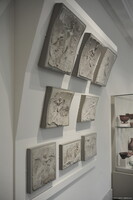Roman Stucco Relief Panels
unknown (Ancient Roman)

Download7A3-MMA-R-SR-A02_cp.jpg (261.1Kb)
Alternate file
Date
50-99Description
Raking view of 8 panels on exhibit, showing curve of upper panels; Stucco (lime plaster) was used not only as the ground for wall frescoes, but also to create three-dimensional architectural moldings and figural reliefs on the upper zones, frequently curved or vaulted, of walls. Worked quickly in damp plaster applied to the still damp ceiling surface, these reliefs preserve the tool marks and even fingerprints of the highly skilled artisans who executed them. Sure anatomical knowledge and draftsmanship are combined with a freshness and spontaneity. These date from the late Julio-Claudian or the Flavian period, the 2nd half of the first century CE. They are related with Dionysiac subject matter. Source: Metropolitan Museum of Art [website]; http://www.metmuseum.org (accessed 5/6/2014)
Type of Work
relief (sculpture)Subject
decorative arts, mythology (Classical), Dionysus (Greek deity), Roman Empire, Early Imperial, Imperial (Roman)
Rights
Rights Statement
Licensed for educational and research use by the MIT community only